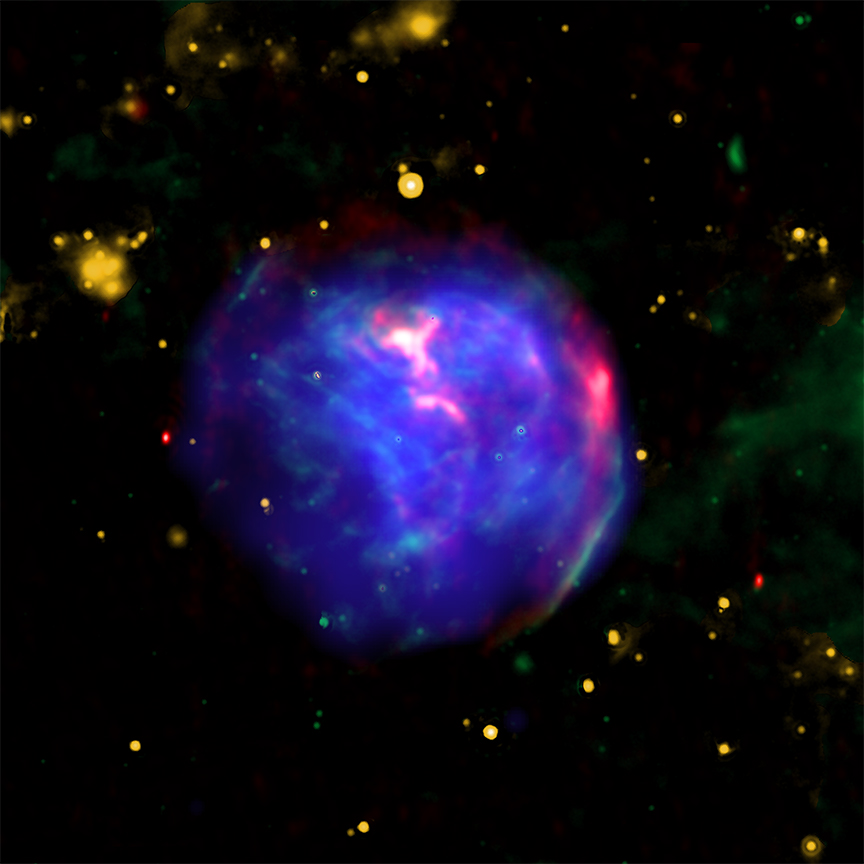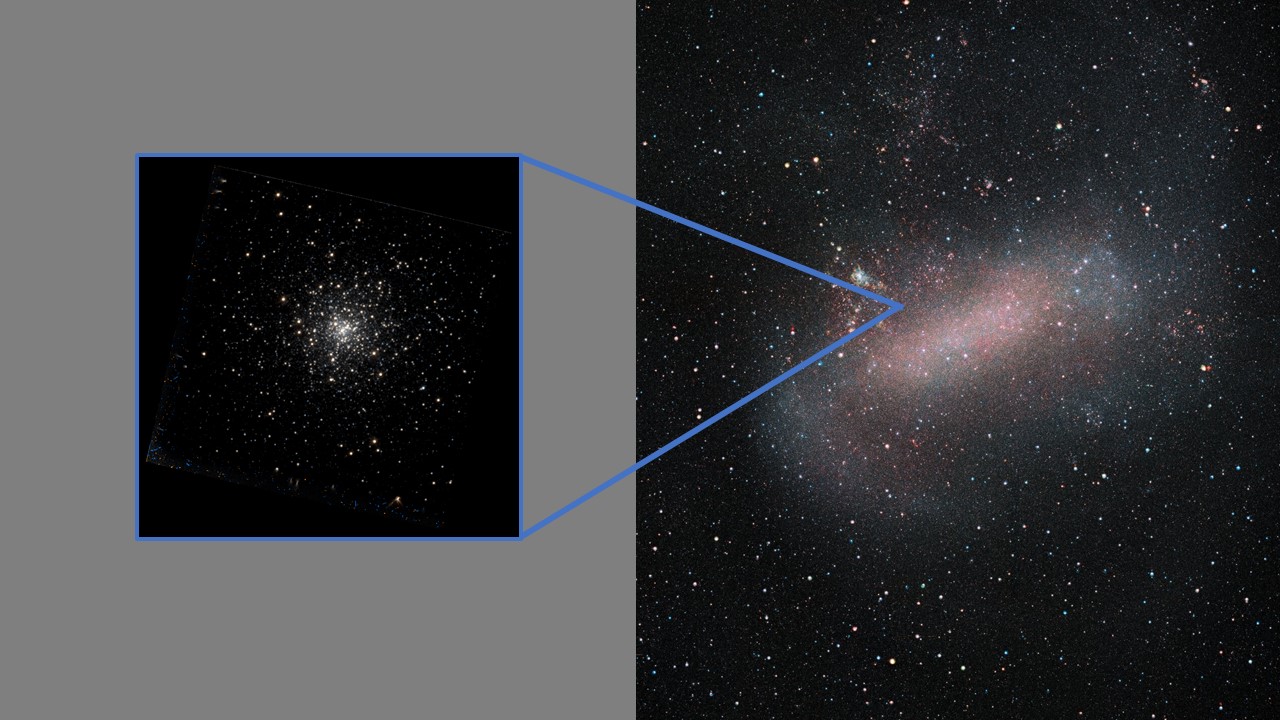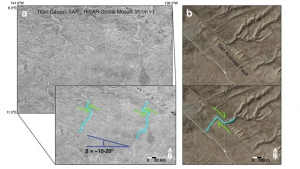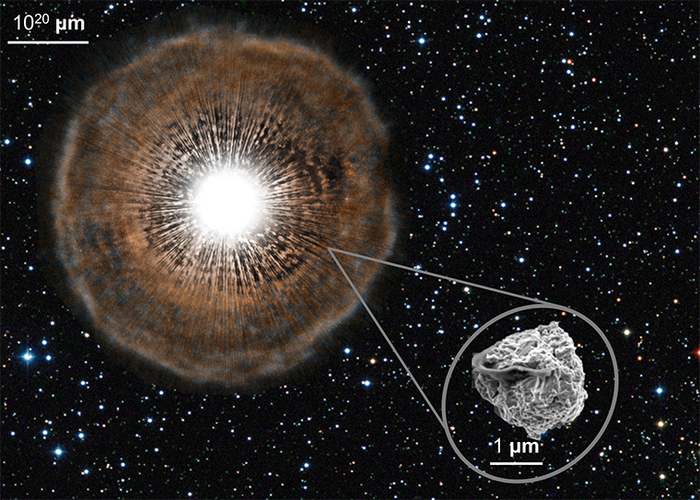Today we whirl through some of the stories that happened last week while we were on hiatus, including pretty images of two galaxies merging and a lovely supernova, as well as news about moons Europa and Titan. Plus, we interview Dr. Julie Rathbun, a senior scientist at the Planetary Science Institute.
Podcast
Show Notes
All the colors of the supernova
- CXO press release
- “Element Stratification in the Middle-Aged Type Ia Supernova Remnant G344.7-0.1,” Kotaro Fukushima et al., accepted to The Astrophysical Journal (preprint on arxiv.org)
Galaxies lose structure in one another’s arms
- NASA image release
Found: Stolen globular cluster
- NOVA press release
- “A relic from a past merger event in the Large Magellanic Cloud,” A. Mucciarelli et al., 2021 October 18, Nature Astronomy
Europa trails water
- NASA Goddard press release
- “A Stable H2O Atmosphere on Europa’s Trailing Hemisphere From HST Images,” Lorenz Roth, 2021 September 13, Geophysical Research Letters
Familiar looking faulting found on Titan
- University of Hawai’i press release
- “Strike-slip faulting on Titan: Modeling tidal stresses and shear failure conditions due to pore fluid interactions,” Liliane M.L.Burkhard et al., 2022 January 1, Icarus
History of stars locked away in rocks
- WUSL press release
- “New Multielement Isotopic Compositions of Presolar SiC Grains: Implications for Their Stellar Origins,” Nan Liu et al., 2021 October 12, The Astrophysical Journal Letters
Lucy in the sky with problems
Transcript
Hello and welcome to the Daily Space. I am your host Dr. Pamela Gay.
And I am your host Beth Johnson.
And we are here to put science in your brain.
After a run-through of stories that came out during our hiatus, we will be joined by Dr. Julie Rathbun, a senior scientist at the Planetary Science Institute whose research focuses on one of my favorite topics – icy moons – as well as my very favorite moon, Io. But first, let’s get to all that news.
We’re going to ease you into the science today with a pretty picture.

This image, which can be found at DailySpace.org, highlights the supernova G344.7-0.1. Light from this exploded star first reached Earth 3-6 thousand years ago. Located about 19,000 light years away, this still-hot nebula allows researchers to study the middle stages in a supernova’s slow expansion toward invisibility.
This particular nova is the result of a white dwarf star cannibalizing another star’s mass until it became unstable. Stars like ours will eventually puff off their outer atmosphere as planetary nebulae, and the remaining hot white dwarf is nothing more than the core of the original Sun-like star.
White dwarfs are supported by the pressure of all the electrons in the star. Electrons naturally repel one another, and due to the Pauli Exclusion Principle, electrons can only have certain energies. If a white dwarf gets too much matter added to it, the electrons can no longer support the star, and the system collapses and undergoes a wild nuclear explosion.
In this new composite image, researchers combined images from the Chandra X-ray Observatory, the now-retired Spitzer infrared telescope, and radio data from the Very Large Array and Australian Telescope Compact Array. The Chandra data showcases the sphere of the expanding nebula in an amazing false-color blue, and like a bubble in modern art, this bubble is painted with cooler infrared, or in false color, green – light where the shock appears to be interacting with the surrounding material. False colored red, radio emission data further highlights the structure of this expanding nebula.
The Chandra images in this composite were acquired to allow researchers led by Kotaro Fukushima to study the distribution of heavy elements in the nebula. Per their paper in The Astrophysical Journal, they found “a clear stratification of heavy elements with a centrally peaked distribution of the [iron] ejecta surrounded by intermediate-mass elements” like silicon, sulfur, argon, and calcium.

You know, there is no reason not to just keep going with the pretty science. This is a space show after all, and space is filled with all kinds of shiny, pretty, stuff.
In our next stop through the universe, we bring you the merging galaxy pair Arp 91. This system consists of two large spiral galaxies that are gravitationally pulling one another together. It is still early days in this particular merger, and these galaxies don’t yet show very much distortion.
When galaxies merge together, it isn’t a single collision; rather the systems come together and pass through one another, before being drawn back together again over and over. These passages can trigger star formation such as is seen in a new image from Hubble Space Telescope. It can also use up or knock out of the galaxies a lot of the remaining material that didn’t form stars. In the end, where we see two, dusty, star-forming galaxies today, there will be one large, no longer forming stars, red elliptical galaxy.
As the story goes, galaxies in the early universe could form in all sizes through the collapse of massive clouds of gas. Over time, smaller galaxies would continue to form through the collapse of gas into stars, but new larger galaxies would only be formed through the merger of smaller systems. It’s a good story, but the question becomes, at what point does this breakdown? Just how small of a system can form through mergers? To find out, researchers examined the stellar population of the nearby Large Magellanic Cloud.
This southern hemisphere sky object looks like a cloud reflecting backlight but is actually a dwarf irregular galaxy that is zipping past our galaxy. Using the Very Large Telescope and Magellan telescopes in Chile, researchers led by Alessio Mucciarelli studied the compositions of stars in this galaxy’s various globular clusters.

When a galaxy merges with a galaxy, the resulting system contains the globular star clusters from both systems, and these clusters’ stars reflect the chemistry of where they formed. And one of their observed globular clusters did not form with the others. Designated NGC 2005, this system may be all that remains recognizable from a small dwarf galaxy the LMC merged with in the past. All other stars and gas from this former system have thoroughly mixed into the LMC, becoming indistinguishable from stars that formed in other parts of our universe.
And now for planetary news.
In 2013, plumes of liquid were imaged erupting from the surface of Jupiter’s moon Europa. These plumes came from geysers that sent freezing liquids up to sixty miles high.
In a new study appearing in Geophysical Research Letters, author Lorenz Roth goes through the Hubble Space Telescope’s archives looking for data that would allow them to measure the distribution of oxygen molecules around Europa. When looking at the trailing side of Europa, they find that oxygen appears in both H2O molecules (water) and molecular oxygen or O2. On the opposite, leading side, only molecular oxygen is present. This is interpreted to mean that geysers are only on the trailing side of Europa.

Like Earth’s moon, Europa is tidally locked, so the same face is always facing Jupiter, and the same sides are always facing into its motion and away from its motion. Why does this matter in the geysers? The paper hints at tidal interactions and more observations are needed.
From Jupiter’s moon Europa to Saturn’s moon Titan, there are curious and interesting bodies in our solar system that, while they don’t look like Earth, may share unexpected similarities. And one of those similarities is a kind of faulting we definitely see here on Earth – the strike-slip fault.
Just like the San Andreas fault here in California, strike slip faults occur when two plates push past each other, rubbing edges as they do. The edges stick – the strike part of the description – and occasionally unstick – the slip part of the description – causing medium to large quakes as they shift. We’ve found these same types of faults on icy moons like Europa and Saturn’s moon Enceladus, and now we’ve possibly found them on Titan. However, the mechanism differs between those moons.
For Europa and Enceladus, the faulting is driven by the tidal stress on the moon by its gas giant and other moons. For Titan, which is as big as Mercury, the faulting may be the result of something more — pore fluid pressures that arise from all the liquid hydrocarbons on and beneath the surface. In particular, these shear faults seem to arise near the equator.

Lead author of this new paper, published in Icarus, Liliane Burkhard notes: Our results suggest that under these conditions, shear failure is not only possible, but may be an active deformation mechanism on the surface and in the subsurface of Titan, and could potentially serve as a pathway for subsurface liquids to rise to the surface. This can potentially facilitate material transport that could affect habitability.
And now we wait for all those icy moon missions to launch, get to Jupiter and Saturn, and send back data. It’s pretty amazing to me how much we still have to learn about our solar system.
Before our solar system formed, a number of stars lived and died and gave up their atmospheres to create the rich mix of elements that went on to form our solar system. While hydrogen, helium, and trace amounts of lithium and beryllium were produced during the Big Bang, everything else came from stars, and different stars brought us different materials in differing amounts.
Here on Earth, we can’t pick up any random rock and use it to understand the kinds of stars that went into our system’s formation; their contents are just too mixed by all the different factors that structured our world. We can, however, pick up some very particular rocks – meteorites – and study their contents to get unprocessed pockets of that original material. If you’ve ever bitten into a homemade cookie and found a blob of unmixed flour, you’ve hit the kind of unprocessed leftovers that researchers are looking for.

In general, meteorites consist of outer layers of material that have been affected through interaction with sunlight and impacts with cosmic rays and other grains and rocks. In a lab, however, raw materials can be found. According to study lead author Nan Liu: Presolar grains have been embedded in meteorites for 4.6 billion years and are sometimes coated with solar materials on the surface.
They used sensitive instruments that allowed them to knock grains off the meteorite very carefully, just molecules at a time. As they burrowed, they found that its chemistry changed both as a reflection of the contents of the meteorite but also in response to the ions used to burrow through the meteorite. By documenting both actual changes and ion gun related changes, they were able to explain odd abundances in other meteorites and to link the contents to different kinds of carbon stars. As Liu states: As we learn more about the sources for dust, we can gain additional knowledge about the history of the universe and how various stellar objects within it evolve.
As a final note, we want to congratulate NASA’s Lucy team for their successful launch on Saturday, Oct 16. According to a NASA update: Lucy’s two solar arrays have deployed, and both are producing power and the battery is charging. While one of the arrays has latched, indications are that the second array may not be fully latched… The team is analyzing spacecraft data to understand the situation and determine next steps to achieve full deployment of the solar array.
To be clear, everything is working and all of Lucy’s subsystems are currently checking out as normal. We wish everyone associated with the mission well, and hope they can get everything locked in place quickly.
Interview
Joining me now is Dr. Julie Rathbun, a senior scientist at the Planetary Science Institute. Dr. Rathbun’s research focuses on icy satellites in our solar system, but her particular love is Jupiter’s volcanic moon, Io. Io is the most volcanically active body in our solar system due to the constant push and pulls of tidal stress from Jupiter and the other Galilean moons. Dr. Rathbun developed a model to explain how Loki, currently the most powerful volcano on the moon, operates. She has worked on numerous missions, including Cassini, New Horizons, and now the upcoming Europa Clipper mission, and we are very excited to have her with us today.
Thank you and welcome, Dr. Rathbun.
[Transcript unavailable]
This has been the Daily Space.
You can find more information on all our stories, including images, at DailySpace.org. As always, we’re here thanks to the donations of people like you. If you like our content, please consider joining our Patreon at Patreon.com/CosmoQuestX.
Credits
Written by Pamela Gay and Beth Johnson
Hosted by Pamela Gay and Beth Johnson
Audio and Video Editing by Ally Pelphrey
Content Editing by Beth Johnson
Intro and Outro music by Kevin MacLeod, https://incompetech.com/music/


 We record most shows live, on Twitch. Follow us today to get alerts when we go live.
We record most shows live, on Twitch. Follow us today to get alerts when we go live.